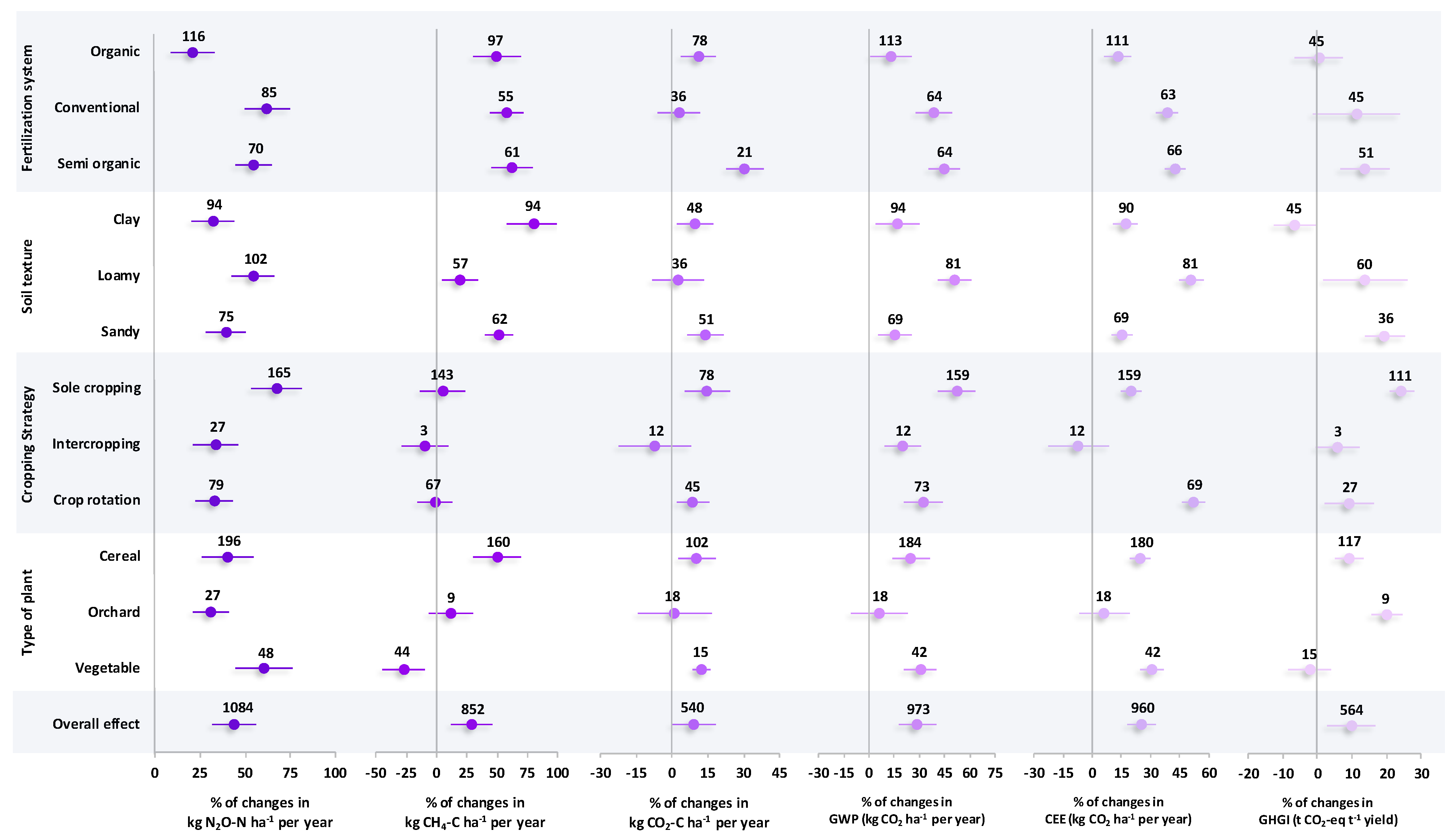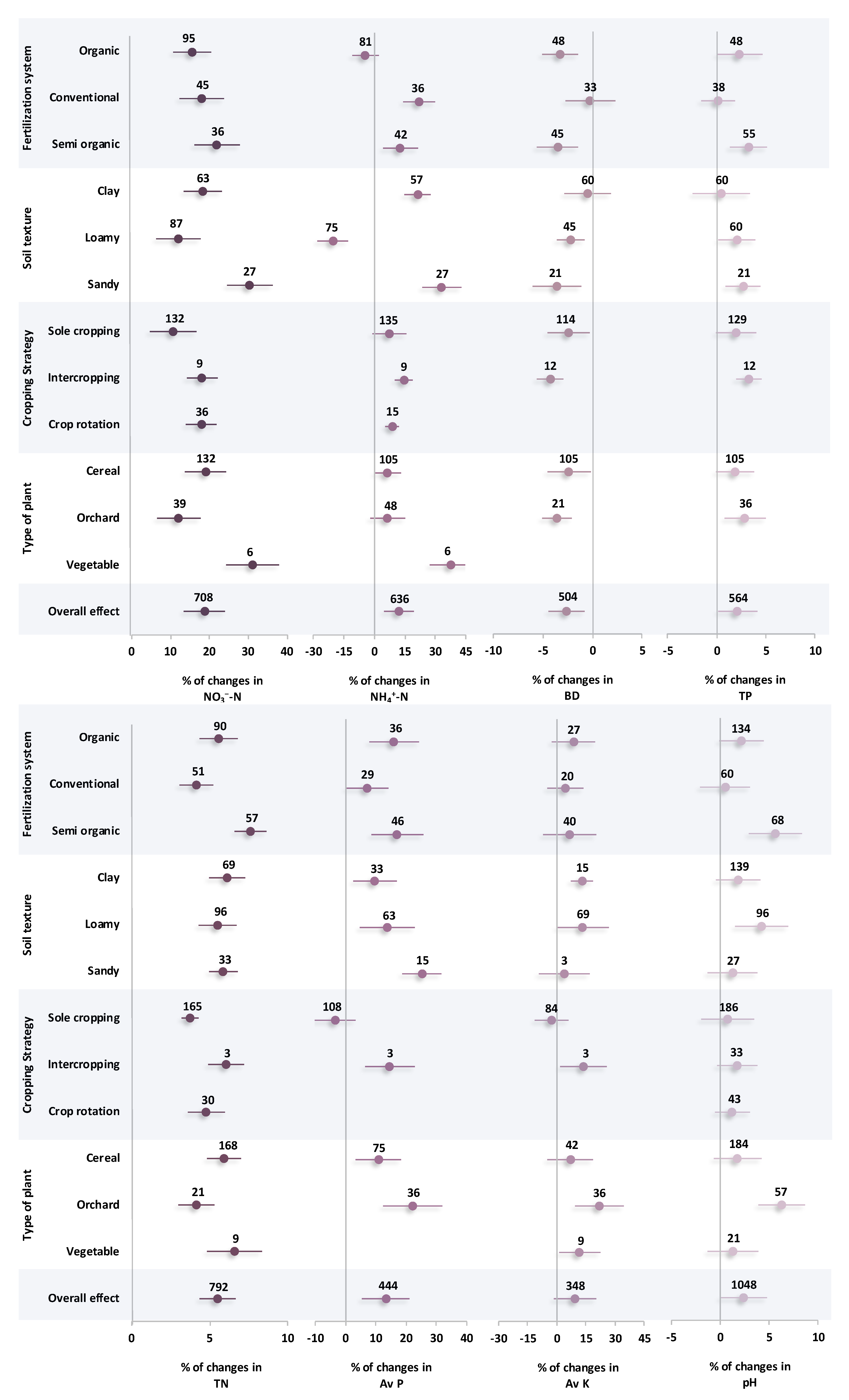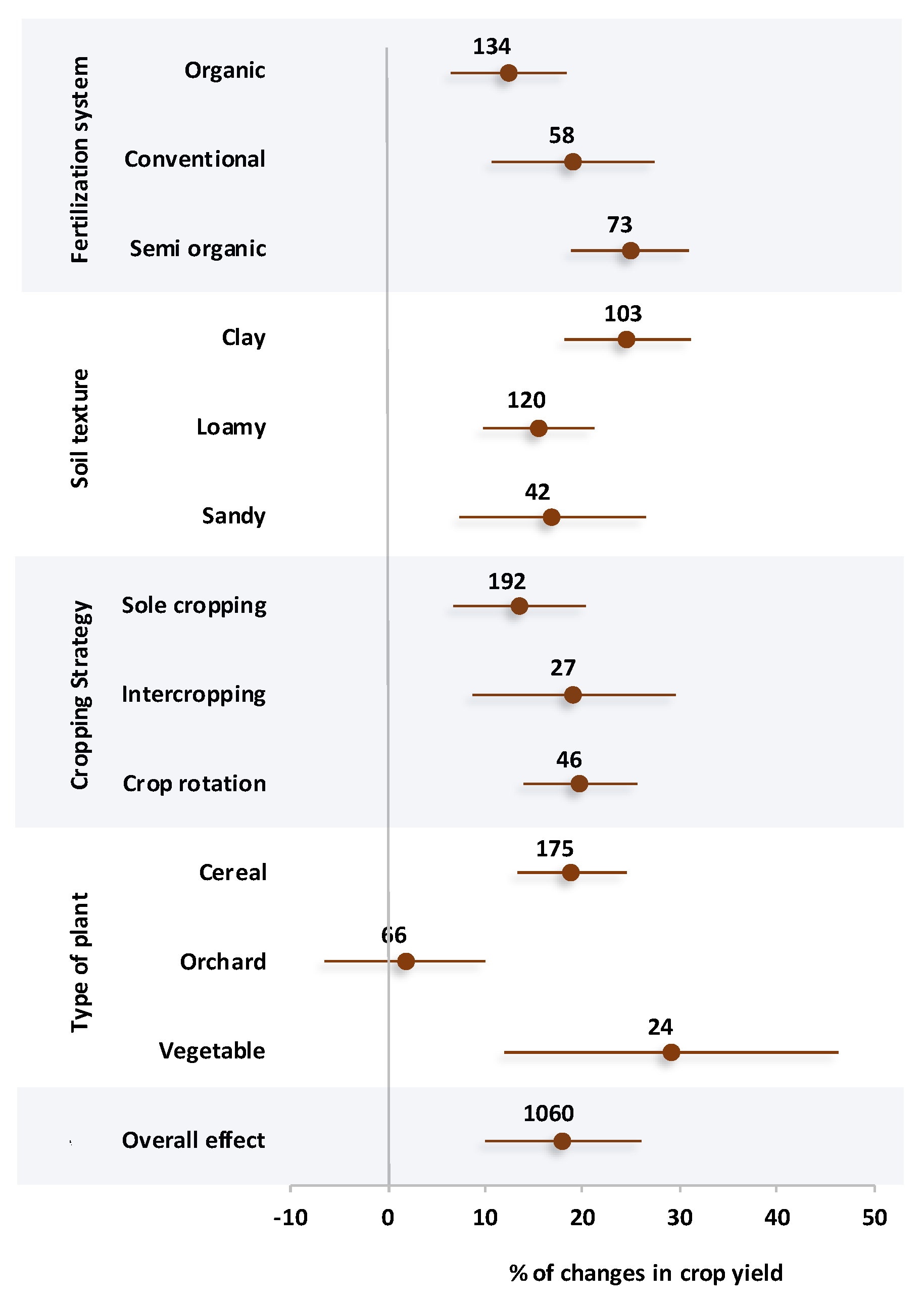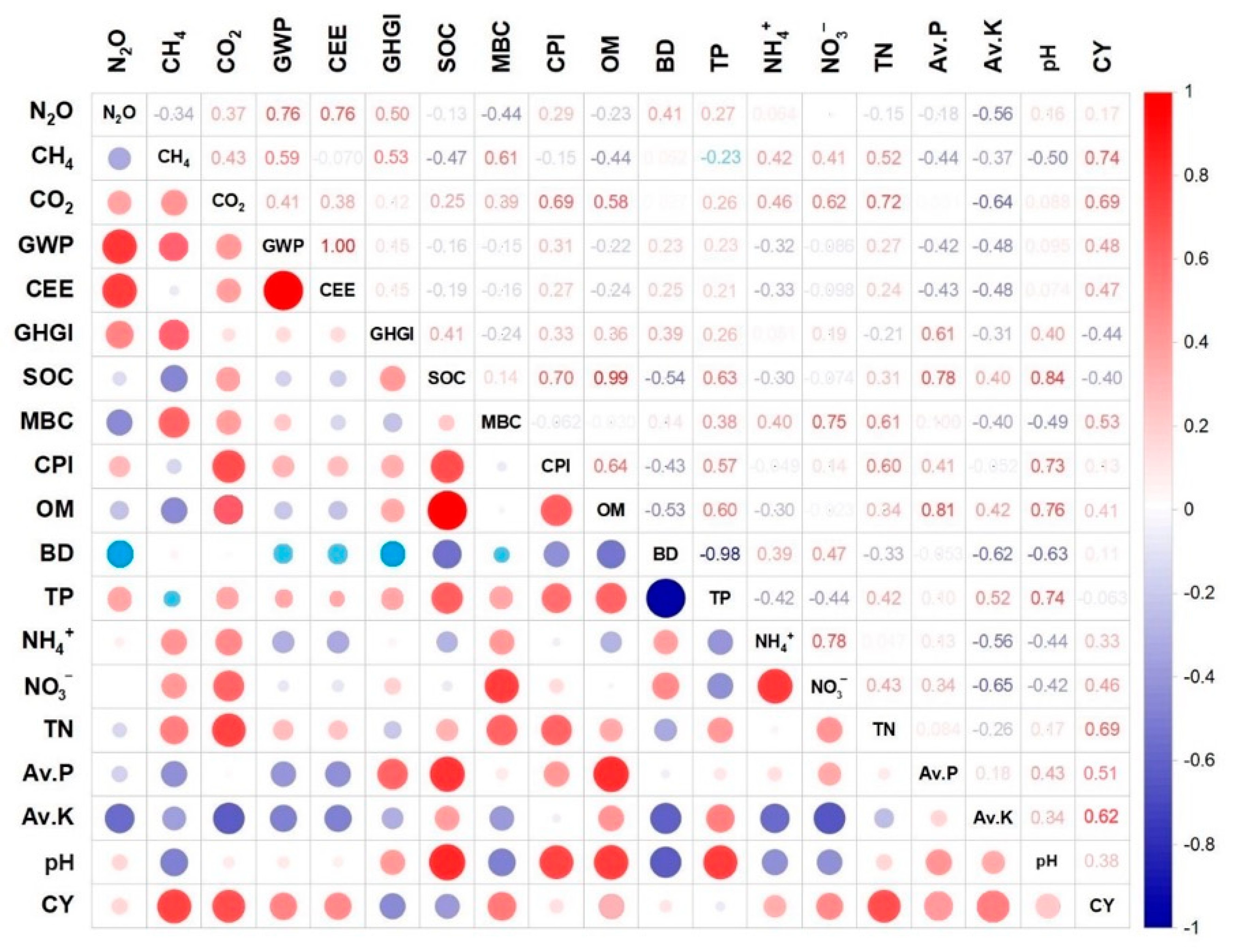Unpacking the Trade-Offs: A Meta-Analysis of Soil Fertility, Crop Yield, and Greenhouse Gas Emissions Across Fertilizer Types (Organic, Mineral) and Cropping Systems
Abstract
1. Introduction
2. Results
2.1. Changes in GHG Emissions
2.2. Changes in Carbon Indices
2.3. Changes in Soil Properties
2.4. Changes in Crop Yield
2.5. Pearson Correlation Between Affected Factors
3. Discussion
3.1. Fertilization System Contribution Effects
3.2. Soil Texture Effects
3.3. Cropping Strategy Effects
3.4. Type of Crop Effects
4. Material and Methods
4.1. Literature Survey and Eligibility Criteria
4.2. Collection of Data
4.3. Meta-Analyses
4.4. Data Analyses
5. Conclusions
Author Contributions
Funding
Data Availability Statement
Conflicts of Interest
References
- Miller, G.A.; Rees, R.M.; Griffiths, B.S.; Cloy, J.M. Isolating the Effect of Soil Properties on Agricultural Soil Greenhouse Gas Emissions under Controlled Conditions. Soil Use Manag. 2020, 36, 285–298. [Google Scholar] [CrossRef]
- Lowry, C.J.; Robertson, G.P.; Brainard, D.C. Strip-Tillage Decreases Soil Nitrogen Availability and Increases the Potential for N Losses in a Cover Cropped Organic System. Agric. Ecosyst. Environ. 2021, 319, 107524. [Google Scholar] [CrossRef]
- Han, J.; Shi, J.; Zeng, L.; Xu, J.; Wu, L. Impacts of Continuous Excessive Fertilization on Soil Potential Nitrification Activity and Nitrifying Microbial Community Dynamics in Greenhouse System. J. Soils Sediments 2017, 17, 471–480. [Google Scholar] [CrossRef]
- Pearsons, K.A.; Omondi, E.C.; Zinati, G.; Smith, A.; Rui, Y. A Tale of Two Systems: Does Reducing Tillage Affect Soil Health Differently in Long-Term, Side-by-Side Conventional and Organic Agricultural Systems? Soil Tillage Res. 2023, 226, 105562. [Google Scholar] [CrossRef]
- Lauk, C.; Magerl, A.; Le Noë, J.; Theurl, M.C.; Gingrich, S. Analyzing Long-Term Dynamics of Agricultural Greenhouse Gas Emissions in Austria, 1830–2018. Sci. Total Environ. 2024, 911, 168667. [Google Scholar] [CrossRef]
- Chirinda, N.; Olesen, J.E.; Porter, J.R.; Schjønning, P. Soil Properties, Crop Production and Greenhouse Gas Emissions from Organic and Inorganic Fertilizer-Based Arable Cropping Systems. Agric. Ecosyst. Environ. 2010, 139, 584–594. [Google Scholar] [CrossRef]
- Kostensalo, J.; Lemola, R.; Salo, T.; Ukonmaanaho, L.; Turtola, E.; Saarinen, M. A Site-Specific Prediction Model for Nitrogen Leaching in Conventional and Organic Farming. J. Environ. Manag. 2024, 349, 119388. [Google Scholar] [CrossRef] [PubMed]
- Gamage, A.; Gangahagedara, R.; Gamage, J.; Jayasinghe, N.; Kodikara, N.; Suraweera, P.; Merah, O. Role of Organic Farming for Achieving Sustainability in Agriculture. Farming Syst. 2023, 1, 100005. [Google Scholar] [CrossRef]
- Bottazzi, P.; Seck, S.M.; Niang, M.; Moser, S. Beyond Motivations: A Framework Unraveling the Systemic Barriers to Organic Farming Adoption in Northern Senegal. J. Rural Stud. 2023, 104, 103158. [Google Scholar] [CrossRef]
- Basnet, S.; Wood, A.; Röös, E.; Jansson, T.; Fetzer, I.; Gordon, L. Organic Agriculture in a Low-Emission World: Exploring Combined Measures to Deliver a Sustainable Food System in Sweden. Sustain. Sci. 2023, 18, 501–519. [Google Scholar] [CrossRef]
- Squalli, J.; Adamkiewicz, G. The Spatial Distribution of Agricultural Emissions in the United States: The Role of Organic Farming in Mitigating Climate Change. J. Clean. Prod. 2023, 414, 137678. [Google Scholar] [CrossRef]
- Lambotte, M.; De Cara, S.; Brocas, C.; Bellassen, V. Organic Farming Offers Promising Mitigation Potential in Dairy Systems without Compromising Economic Performances. J. Environ. Manag. 2023, 334, 117405. [Google Scholar] [CrossRef]
- Tuomisto, H.L.; Hodge, I.D.; Riordan, P.; Macdonald, D.W. Does Organic Farming Reduce Environmental Impacts?—A Meta-Analysis of European Research. J. Environ. Manag. 2012, 112, 309–320. [Google Scholar] [CrossRef]
- De Ponti, T.; Rijk, B.; Van Ittersum, M.K. The Crop Yield Gap between Organic and Conventional Agriculture. Agric. Syst. 2012, 108, 1–9. [Google Scholar] [CrossRef]
- Boschiero, M.; De Laurentiis, V.; Caldeira, C.; Sala, S. Comparison of Organic and Conventional Cropping Systems: A Systematic Review of Life Cycle Assessment Studies. Environ. Impact Assess. Rev. 2023, 102, 107187. [Google Scholar] [CrossRef]
- Ali, A.; Jabeen, N.; Farruhbek, R.; Chachar, Z.; Laghari, A.A.; Chachar, S.; Ahmed, N.; Ahmed, S.; Yang, Z. Enhancing Nitrogen Use Efficiency in Agriculture by Integrating Agronomic Practices and Genetic Advances. Front. Plant Sci. 2025, 16, 1543714. [Google Scholar] [CrossRef]
- Mohale, P.M.; Manyevere, A.; Parwada, C.; Zerizghy, M.G. Effect of Eucalyptus Wood-Based Compost Application Rates on Soil Chemical Properties in Semi-Organic Avocado Plantations, Limpopo Province, South Africa. PLoS ONE 2023, 18, e0265728. [Google Scholar] [CrossRef]
- Herdiansyah, G.; Suntoro; Farid, M.; Aziz, M.; Dewi, F.S.; Slamet Rahayu, A. Nitrogen Uptake in Fully Organic, Semi-Organic and Conventional Rice Fields in Madiun Regency. IOP Conf. Ser. Earth Environ. Sci. 2022, 1016, 012011. [Google Scholar] [CrossRef]
- Pérez-Llorca, M.; Jaime-Rodríguez, C.; González-Coria, J.; Lamuela-Raventós, R.M.; Pérez, M.; Vallverdú-Queralt, A.; Hernández, R.; Chantry, O.; Romanyà, J. Increasing Soil Organic Matter and Short-Term Nitrogen Availability by Combining Ramial Chipped Wood with a Crop Rotation Starting with Sweet Potato. Agric. Ecosyst. Environ. 2025, 392, 109740. [Google Scholar] [CrossRef]
- Toda, M.; Walder, F.; Van Der Heijden, M.G.A. Organic Management and Soil Health Promote Nutrient Use Efficiency. J. Sustain. Agric. Environ. 2023, 2, 215–224. [Google Scholar] [CrossRef]
- Ding, W.; Meng, L.; Yin, Y.; Cai, Z.; Zheng, X. CO2 Emission in an Intensively Cultivated Loam as Affected by Long-Term Application of Organic Manure and Nitrogen Fertilizer. Soil Biol. Biochem. 2007, 39, 669–679. [Google Scholar] [CrossRef]
- Hu, Y.; Li, D.; Wu, Y.; Liu, S.; Li, L.; Chen, W.; Wu, S.; Meng, Q.; Feng, H.; Siddique, K.H.M. Mitigating Greenhouse Gas Emissions by Replacing Inorganic Fertilizer with Organic Fertilizer in Wheat–Maize Rotation Systems in China. J. Environ. Manag. 2023, 344, 118494. [Google Scholar] [CrossRef] [PubMed]
- Yang, B.; Xiong, Z.; Wang, J.; Xu, X.; Huang, Q.; Shen, Q. Mitigating Net Global Warming Potential and Greenhouse Gas Intensities by Substituting Chemical Nitrogen Fertilizers with Organic Fertilization Strategies in Rice–Wheat Annual Rotation Systems in China: A 3-Year Field Experiment. Ecol. Eng. 2015, 81, 289–297. [Google Scholar] [CrossRef]
- Ozlu, E.; Kumar, S. Response of Surface GHG Fluxes to Long-Term Manure and Inorganic Fertilizer Application in Corn and Soybean Rotation. Sci. Total Environ. 2018, 626, 817–825. [Google Scholar] [CrossRef]
- Hansen, L.V.; Brændholt, A.; Tariq, A.; Jensen, L.S.; Peixoto, L.E.K.; Petersen, S.O.; Bruun, S. Methane Uptake Rates across Different Soil Types and Agricultural Management Practices in Denmark. Agric. Ecosyst. Environ. 2024, 363, 108878. [Google Scholar] [CrossRef]
- Zhang, Y.; Cui, M.; Duan, J.; Zhuang, X.; Zhuang, G.; Ma, A. Abundance, Rather than Composition, of Methane-cycling Microbes Mainly Affects Methane Emissions from Different Vegetation Soils in the Zoige Alpine Wetland. MicrobiologyOpen 2019, 8, e00699. [Google Scholar] [CrossRef] [PubMed]
- Aronson, E.L.; Allison, S.D.; Helliker, B.R. Environmental Impacts on the Diversity of Methane-Cycling Microbes and Their Resultant Function. Front. Microbiol. 2013, 4, 225. [Google Scholar] [CrossRef]
- Erkkilä, A.; Tenkanen, M.; Tsuruta, A.; Rautiainen, K.; Aalto, T. Environmental and Seasonal Variability of High Latitude Methane Emissions Based on Earth Observation Data and Atmospheric Inverse Modelling. Remote Sens. 2023, 15, 5719. [Google Scholar] [CrossRef]
- Cuello, J.P.; Hwang, H.Y.; Gutierrez, J.; Kim, S.Y.; Kim, P.J. Impact of Plastic Film Mulching on Increasing Greenhouse Gas Emissions in Temperate Upland Soil during Maize Cultivation. Appl. Soil Ecol. 2015, 91, 48–57. [Google Scholar] [CrossRef]
- Squalli, J.; Adamkiewicz, G. Organic Farming and Greenhouse Gas Emissions: A Longitudinal U.S. State-Level Study. J. Clean. Prod. 2018, 192, 30–42. [Google Scholar] [CrossRef]
- Zhang, X.; Wu, L.; Sun, N.; Ding, X.; Li, J.; Wang, B.; Li, D. Soil CO2 and N2O Emissions in Maize Growing Season Under Different Fertilizer Regimes in an Upland Red Soil Region of South China. J. Integr. Agric. 2014, 13, 604–614. [Google Scholar] [CrossRef]
- Ghorbani, M.; Amirahmadi, E. Effect of Rice Husk Biochar on Some Physical Characteristics of Soil and Corn Growth in a Loamy Soil. Iran. J. Soil Res. 2018, 32, 305–318. [Google Scholar] [CrossRef]
- Amirahmadi, E.; Ghorbani, M.; Moudrý, J. Effects of Zeolite on Aggregation, Nutrient Availability, and Growth Characteristics of Corn (Zea mays L.) in Cadmium-Contaminated Soils. Water Air Soil Pollut. 2022, 233, 436. [Google Scholar] [CrossRef]
- Liu, B.; Wang, X.; Ma, L.; Chadwick, D.; Chen, X. Combined Applications of Organic and Synthetic Nitrogen Fertilizers for Improving Crop Yield and Reducing Reactive Nitrogen Losses from China’s Vegetable Systems: A Meta-Analysis. Environ. Pollut. 2021, 269, 116143. [Google Scholar] [CrossRef]
- Menegat, S.; Ledo, A.; Tirado, R. Greenhouse Gas Emissions from Global Production and Use of Nitrogen Synthetic Fertilisers in Agriculture. Sci. Rep. 2022, 12, 14490. [Google Scholar] [CrossRef] [PubMed]
- Dungan, R.S.; Leytem, A.B.; Moore, A.D.; Bjorneberg, D.L.; Grace, P.R.; Brunk, C.; Rowlings, D.W. Growing and Non-Growing Season Nitrous Oxide Emissions from a Manured Semiarid Cropland Soil under Irrigation. Agric. Ecosyst. Environ. 2023, 348, 108413. [Google Scholar] [CrossRef]
- Fan, X.; Chen, X.; Chen, T.; Liu, X.; Song, Y.; Tan, S.; Chen, Y.; Yan, P.; Wang, X. Effects of Substituting Synthetic Nitrogen with Organic Amendments on Crop Yield, Net Greenhouse Gas Emissions and Carbon Footprint: A Global Meta-Analysis. Field Crops Res. 2023, 301, 109035. [Google Scholar] [CrossRef]
- Chen, M.; Wang, X.; Ding, X.; Liu, L.; Wu, L.; Zhang, S. Effects of Organic Fertilization on Phosphorus Availability and Crop Growth: Evidence from a 7-Year Fertilization Experiment. Arch. Agron. Soil Sci. 2023, 69, 2092–2103. [Google Scholar] [CrossRef]
- Lamlom, S.F.; Irshad, A.; Mosa, W.F.A. The Biological and Biochemical Composition of Wheat (Triticum aestivum) as Affected by the Bio and Organic Fertilizers. BMC Plant Biol. 2023, 23, 111. [Google Scholar] [CrossRef]
- Yang, X.; Sun, B.; Zhang, S. Trends of Yield and Soil Fertility in a Long-Term Wheat-Maize System. J. Integr. Agric. 2014, 13, 402–414. [Google Scholar] [CrossRef]
- Zheng, J.; Berns-Herrboldt, E.C.; Gu, B.; Wullschleger, S.D.; Graham, D.E. Quantifying pH Buffering Capacity in Acidic, Organic-Rich Arctic Soils: Measurable Proxies and Implications for Soil Carbon Degradation. Geoderma 2022, 424, 116003. [Google Scholar] [CrossRef]
- Naeem, A.; Deppermann, P.; Mühling, K.H. Ammonium Fertilization Enhances Nutrient Uptake, Specifically Manganese and Zinc, and Growth of Maize in Unlimed and Limed Acidic Sandy Soil. Nitrogen 2023, 4, 239–252. [Google Scholar] [CrossRef]
- Yang, M.; Zhou, D.; Hang, H.; Chen, S.; Liu, H.; Su, J.; Lv, H.; Jia, H.; Zhao, G. Effects of Balancing Exchangeable Cations Ca, Mg, and K on the Growth of Tomato Seedlings (Solanum lycopersicum L.) Based on Increased Soil Cation Exchange Capacity. Agronomy 2024, 14, 629. [Google Scholar] [CrossRef]
- Ghorbani, M.; Asadi, H.; Abrishamkesh, S. Effects of Rice Husk Biochar on Selected Soil Properties and Nitrate Leaching in Loamy Sand and Clay Soil. Int. Soil Water Conserv. Res. 2019, 7, 258–265. [Google Scholar] [CrossRef]
- Jalota, S.K.; Singh, S.; Chahal, G.B.S.; Ray, S.S.; Panigraghy, S.; Bhupinder-Singh; Singh, K.B. Soil Texture, Climate and Management Effects on Plant Growth, Grain Yield and Water Use by Rainfed Maize–Wheat Cropping System: Field and Simulation Study. Agric. Water Manag. 2010, 97, 83–90. [Google Scholar] [CrossRef]
- Mangalassery, S.; Sjögersten, S.; Sparkes, D.L.; Sturrock, C.J.; Mooney, S.J. The Effect of Soil Aggregate Size on Pore Structure and Its Consequence on Emission of Greenhouse Gases. Soil Tillage Res. 2013, 132, 39–46. [Google Scholar] [CrossRef]
- Alskaf, K.; Mooney, S.J.; Sparkes, D.L.; Wilson, P.; Sjögersten, S. Short-Term Impacts of Different Tillage Practices and Plant Residue Retention on Soil Physical Properties and Greenhouse Gas Emissions. Soil Tillage Res. 2021, 206, 104803. [Google Scholar] [CrossRef]
- Ariani, M.; Hanudin, E.; Haryono, E. The Effect of Contrasting Soil Textures on the Efficiency of Alternate Wetting-Drying to Reduce Water Use and Global Warming Potential. Agric. Water Manag. 2022, 274, 107970. [Google Scholar] [CrossRef]
- Doyeni, M.O.; Baksinskaite, A.; Suproniene, S.; Tilvikiene, V. Effect of Animal Waste Based Digestate Fertilization on Soil Microbial Activities, Greenhouse Gas Emissions and Spring Wheat Productivity in Loam and Sandy Loam Soil. Agronomy 2021, 11, 1281. [Google Scholar] [CrossRef]
- Shakoor, A.; Shakoor, S.; Rehman, A.; Ashraf, F.; Abdullah, M.; Shahzad, S.M.; Farooq, T.H.; Ashraf, M.; Manzoor, M.A.; Altaf, M.M.; et al. Effect of Animal Manure, Crop Type, Climate Zone, and Soil Attributes on Greenhouse Gas Emissions from Agricultural Soils—A Global Meta-Analysis. J. Clean. Prod. 2021, 278, 124019. [Google Scholar] [CrossRef]
- Ismail, S.M.; Ozawa, K. Improvement of Crop Yield, Soil Moisture Distribution and Water Use Efficiency in Sandy Soils by Clay Application. Appl. Clay Sci. 2007, 37, 81–89. [Google Scholar] [CrossRef]
- Arvidsson, J. Influence of Soil Texture and Organic Matter Content on Bulk Density, Air Content, Compression Index and Crop Yield in Field and Laboratory Compression Experiments. Soil Tillage Res. 1998, 49, 159–170. [Google Scholar] [CrossRef]
- Dou, F.; Soriano, J.; Tabien, R.E.; Chen, K. Soil Texture and Cultivar Effects on Rice (Oryza sativa, L.) Grain Yield, Yield Components and Water Productivity in Three Water Regimes. PLoS ONE 2016, 11, e0150549. [Google Scholar] [CrossRef]
- Yang, L.; Tan, L.; Zhang, F.; Gale, W.J.; Cheng, Z.; Sang, W. Duration of Continuous Cropping with Straw Return Affects the Composition and Structure of Soil Bacterial Communities in Cotton Fields. Can. J. Microbiol. 2018, 64, 167–181. [Google Scholar] [CrossRef]
- Ghani, M.I.; Ali, A.; Atif, M.J.; Pathan, S.I.; Pietramellara, G.; Ali, M.; Amin, B.; Cheng, Z. Diversified Crop Rotation Improves Continuous Monocropping Eggplant Production by Altering the Soil Microbial Community and Biochemical Properties. Plant Soil 2022, 480, 603–624. [Google Scholar] [CrossRef]
- Su, F.; Li, Y.; Qian, J.; Wang, Y.; Zhang, Y. Does the Repeated Freezing and Thawing of the Aerobic Layer Affect the Anaerobic Release of N2O from SWIS? Sci. Total Environ. 2023, 859, 160313. [Google Scholar] [CrossRef]
- Yu, L.; Tang, Y.; Wang, Z.; Gou, Y.; Wang, J. Nitrogen-Cycling Genes and Rhizosphere Microbial Community with Reduced Nitrogen Application in Maize/Soybean Strip Intercropping. Nutr. Cycl. Agroecosyst. 2019, 113, 35–49. [Google Scholar] [CrossRef]
- Chapagain, T.; Pudasaini, R.; Ghimire, B.; Gurung, K.; Choi, K.; Rai, L.; Magar, S.; Bk, B.; Raizada, M.N. Intercropping of Maize, Millet, Mustard, Wheat and Ginger Increased Land Productivity and Potential Economic Returns for Smallholder Terrace Farmers in Nepal. Field Crops Res. 2018, 227, 91–101. [Google Scholar] [CrossRef]
- Wang, X.; Chen, Y.; Yang, K.; Duan, F.; Liu, P.; Wang, Z.; Wang, J. Effects of Legume Intercropping and Nitrogen Input on Net Greenhouse Gas Balances, Intensity, Carbon Footprint and Crop Productivity in Sweet Maize Cropland in South China. J. Clean. Prod. 2021, 314, 127997. [Google Scholar] [CrossRef]
- Alluvione, F.; Halvorson, A.D.; Del Grosso, S.J. Nitrogen, Tillage, and Crop Rotation Effects on Carbon Dioxide and Methane Fluxes from Irrigated Cropping Systems. J. Environ. Qual. 2009, 38, 2023–2033. [Google Scholar] [CrossRef] [PubMed]
- Sainju, U.M.; Ghimire, R.; Dangi, S. Soil Carbon Dioxide and Methane Emissions and Carbon Balance with Crop Rotation and Nitrogen Fertilization. Sci. Total Environ. 2021, 775, 145902. [Google Scholar] [CrossRef]
- Pereira, B.D.J.; Cecílio Filho, A.B.; La Scala, N. Greenhouse Gas Emissions and Carbon Footprint of Cucumber, Tomato and Lettuce Production Using Two Cropping Systems. J. Clean. Prod. 2021, 282, 124517. [Google Scholar] [CrossRef]
- Brankatschk, G.; Finkbeiner, M. Crop Rotations and Crop Residues Are Relevant Parameters for Agricultural Carbon Footprints. Agron. Sustain. Dev. 2017, 37, 58. [Google Scholar] [CrossRef]
- Semenov, V.M.; Pautova, N.B.; Lebedeva, T.N.; Khromychkina, D.P.; Semenova, N.A.; Lopes De Gerenyu, V.O. Plant Residues Decomposition and Formation of Active Organic Matter in the Soil of the Incubation Experiments. Eurasian Soil Sci. 2019, 52, 1183–1194. [Google Scholar] [CrossRef]
- Gui, D.; Zhang, Y.; Lv, J.; Guo, J.; Sha, Z. Effects of Intercropping on Soil Greenhouse Gas Emissions—A Global Meta-Analysis. Sci. Total Environ. 2024, 918, 170632. [Google Scholar] [CrossRef]
- Marcos-Pérez, M.; Sánchez-Navarro, V.; Zornoza, R. Soil Greenhouse Gas Emissions in Intercropped Systems Between Melon and Cowpea. Span. J. Soil Sci. 2023, 13, 11368. [Google Scholar] [CrossRef]
- Zhang, Y.; Han, M.; Song, M.; Tian, J.; Song, B.; Hu, Y.; Zhang, J.; Yao, Y. Intercropping With Aromatic Plants Increased the Soil Organic Matter Content and Changed the Microbial Community in a Pear Orchard. Front. Microbiol. 2021, 12, 616932. [Google Scholar] [CrossRef]
- Wang, D.; Yu, W.; Ming, C.; Chen, L.; Zhao, P.; Shi, X.; Zhao, Z.; Fan, M.; Long, G. Intercropping Enhances Stable Soil Organic Carbon Pool through Macroaggregate Protection and Biochemical Recalcitrance Interactions. Agric. Ecosyst. Environ. 2025, 388, 109654. [Google Scholar] [CrossRef]
- Xavier, C.V.; Moitinho, M.R.; De Bortoli Teixeira, D.; André De Araújo Santos, G.; De Andrade Barbosa, M.; Bastos Pereira Milori, D.M.; Rigobelo, E.; Corá, J.E.; La Scala Júnior, N. Crop Rotation and Succession in a No-Tillage System: Implications for CO2 Emission and Soil Attributes. J. Environ. Manag. 2019, 245, 8–15. [Google Scholar] [CrossRef] [PubMed]
- Hao, Q.; Jiang, C.; Chai, X.; Huang, Z.; Fan, Z.; Xie, D.; He, X. Drainage, No-Tillage and Crop Rotation Decreases Annual Cumulative Emissions of Methane and Nitrous Oxide from a Rice Field in Southwest China. Agric. Ecosyst. Environ. 2016, 233, 270–281. [Google Scholar] [CrossRef]
- Weller, S.; Kraus, D.; Ayag, K.R.P.; Wassmann, R.; Alberto, M.C.R.; Butterbach-Bahl, K.; Kiese, R. Methane and Nitrous Oxide Emissions from Rice and Maize Production in Diversified Rice Cropping Systems. Nutr. Cycl. Agroecosyst. 2015, 101, 37–53. [Google Scholar] [CrossRef]
- Asadi, H.; Ghorbani, M.; Rezaei-Rashti, M.; Abrishamkesh, S.; Amirahmadi, E.; Chengrong, C.; Gorji, M. Application of Rice Husk Biochar for Achieving Sustainable Agriculture and Environment. Rice Sci. 2021, 28, 325–343. [Google Scholar] [CrossRef]
- Khanal, U.; Stott, K.J.; Armstrong, R.; Nuttall, J.G.; Henry, F.; Christy, B.P.; Mitchell, M.; Riffkin, P.A.; Wallace, A.J.; McCaskill, M.; et al. Intercropping—Evaluating the Advantages to Broadacre Systems. Agriculture 2021, 11, 453. [Google Scholar] [CrossRef]
- Li, Q.-Z.; Sun, J.-H.; Wei, X.-J.; Christie, P.; Zhang, F.-S.; Li, L. Overyielding and Interspecific Interactions Mediated by Nitrogen Fertilization in Strip Intercropping of Maize with Faba Bean, Wheat and Barley. Plant Soil 2011, 339, 147–161. [Google Scholar] [CrossRef]
- Wang, Z.-G.; Jin, X.; Bao, X.-G.; Li, X.-F.; Zhao, J.-H.; Sun, J.-H.; Christie, P.; Li, L. Intercropping Enhances Productivity and Maintains the Most Soil Fertility Properties Relative to Sole Cropping. PLoS ONE 2014, 9, e113984. [Google Scholar] [CrossRef]
- Liu, X.; Hannula, S.E.; Li, X.; Hundscheid, M.P.J.; Klein Gunnewiek, P.J.A.; Clocchiatti, A.; Ding, W.; De Boer, W. Decomposing Cover Crops Modify Root-Associated Microbiome Composition and Disease Tolerance of Cash Crop Seedlings. Soil Biol. Biochem. 2021, 160, 108343. [Google Scholar] [CrossRef]
- Xing, T.; Cai, A.; Lu, C.; Ye, H.; Wu, H.; Huai, S.; Wang, J.; Xu, M.; Lin, Q. Increasing Soil Microbial Biomass Nitrogen in Crop Rotation Systems by Improving Nitrogen Resources under Nitrogen Application. J. Integr. Agric. 2022, 21, 1488–1500. [Google Scholar] [CrossRef]
- Andrade, J.F.; Cerrudo, A.; Rizzalli, R.H.; Monzon, J.P. Sunflower–Soybean Intercrop Productivity under Different Water Conditions and Sowing Managements. Agron. J. 2012, 104, 1049–1055. [Google Scholar] [CrossRef]
- Cotrufo, M.F.; Wallenstein, M.D.; Boot, C.M.; Denef, K.; Paul, E. The Microbial Efficiency-Matrix Stabilization (MEMS) Framework Integrates Plant Litter Decomposition with Soil Organic Matter Stabilization: Do Labile Plant Inputs Form Stable Soil Organic Matter? Glob. Change Biol. 2013, 19, 988–995. [Google Scholar] [CrossRef] [PubMed]
- Lyu, M.; Li, X.; Xie, J.; Homyak, P.M.; Ukonmaanaho, L.; Yang, Z.; Liu, X.; Ruan, C.; Yang, Y. Root–Microbial Interaction Accelerates Soil Nitrogen Depletion but Not Soil Carbon after Increasing Litter Inputs to a Coniferous Forest. Plant Soil 2019, 444, 153–164. [Google Scholar] [CrossRef]
- Xiong, W.; Zhao, Q.; Zhao, J.; Xun, W.; Li, R.; Zhang, R.; Wu, H.; Shen, Q. Different Continuous Cropping Spans Significantly Affect Microbial Community Membership and Structure in a Vanilla-Grown Soil as Revealed by Deep Pyrosequencing. Microb. Ecol. 2015, 70, 209–218. [Google Scholar] [CrossRef] [PubMed]
- Aziz, U.; Rehmani, M.S.; Wang, L.; Luo, X.; Xian, B.; Wei, S.; Wang, G.; Shu, K. Toward a Molecular Understanding of Rhizosphere, Phyllosphere, and Spermosphere Interactions in Plant Growth and Stress Response. Crit. Rev. Plant Sci. 2021, 40, 479–500. [Google Scholar] [CrossRef]
- Zhou, Y.; Gao, B.; Zimmerman, A.R.; Fang, J.; Sun, Y.; Cao, X. Sorption of Heavy Metals on Chitosan-Modified Biochars and Its Biological Effects. Chem. Eng. J. 2013, 231, 512–518. [Google Scholar] [CrossRef]
- Ali, A.; Imran Ghani, M.; Li, Y.; Ding, H.; Meng, H.; Cheng, Z. Hiseq Base Molecular Characterization of Soil Microbial Community, Diversity Structure, and Predictive Functional Profiling in Continuous Cucumber Planted Soil Affected by Diverse Cropping Systems in an Intensive Greenhouse Region of Northern China. Int. J. Mol. Sci. 2019, 20, 2619. [Google Scholar] [CrossRef]
- Shaw, L.J.; Nicol, G.W.; Smith, Z.; Fear, J.; Prosser, J.I.; Baggs, E.M. Nitrosospira Spp. Can Produce Nitrous Oxide via a Nitrifier Denitrification Pathway. Environ. Microbiol. 2006, 8, 214–222. [Google Scholar] [CrossRef]
- Nishimura, S.; Sawamoto, T.; Akiyama, H.; Sudo, S.; Yagi, K. Methane and Nitrous Oxide Emissions from a Paddy Field with Japanese Conventional Water Management and Fertilizer Application. Glob. Biogeochem. Cycles 2004, 18, 2003GB002207. [Google Scholar] [CrossRef]
- Syakila, A.; Kroeze, C. The Global Nitrous Oxide Budget Revisited. Greenh. Gas Meas. Manag. 2011, 1, 17–26. [Google Scholar] [CrossRef]
- Xu, P.; Han, Z.; Wu, J.; Li, Z.; Wang, J.; Zou, J. Emissions of Greenhouse Gases and NO from Rice Fields and a Peach Orchard as Affected by N Input and Land-Use Conversion. Agronomy 2022, 12, 1850. [Google Scholar] [CrossRef]
- Kritee, K.; Nair, D.; Zavala-Araiza, D.; Proville, J.; Rudek, J.; Adhya, T.K.; Loecke, T.; Esteves, T.; Balireddygari, S.; Dava, O.; et al. High Nitrous Oxide Fluxes from Rice Indicate the Need to Manage Water for Both Long- and Short-Term Climate Impacts. Proc. Natl. Acad. Sci. USA 2018, 115, 9720–9725. [Google Scholar] [CrossRef]
- Thelen, K.D.; Fronning, B.E.; Kravchenko, A.; Min, D.H.; Robertson, G.P. Integrating Livestock Manure with a Corn–Soybean Bioenergy Cropping System Improves Short-Term Carbon Sequestration Rates and Net Global Warming Potential. Biomass Bioenergy 2010, 34, 960–966. [Google Scholar] [CrossRef]
- Smith, K.A. Changing Views of Nitrous Oxide Emissions from Agricultural Soil: Key Controlling Processes and Assessment at Different Spatial Scales. Eur. J. Soil Sci. 2017, 68, 137–155. [Google Scholar] [CrossRef]
- Hedges, L.V.; Gurevitch, J.; Curtis, P.S. The Meta-Analysis of Response Ratios in Experimental Ecology. Ecology 1999, 80, 1150–1156. [Google Scholar] [CrossRef]
- Nave, L.E.; Vance, E.D.; Swanston, C.W.; Curtis, P.S. Harvest Impacts on Soil Carbon Storage in Temperate Forests. For. Ecol. Manag. 2010, 259, 857–866. [Google Scholar] [CrossRef]






Disclaimer/Publisher’s Note: The statements, opinions and data contained in all publications are solely those of the individual author(s) and contributor(s) and not of MDPI and/or the editor(s). MDPI and/or the editor(s) disclaim responsibility for any injury to people or property resulting from any ideas, methods, instructions or products referred to in the content. |
© 2025 by the authors. Licensee MDPI, Basel, Switzerland. This article is an open access article distributed under the terms and conditions of the Creative Commons Attribution (CC BY) license (https://creativecommons.org/licenses/by/4.0/).
Share and Cite
Amirahmadi, E.; Ghorbani, M. Unpacking the Trade-Offs: A Meta-Analysis of Soil Fertility, Crop Yield, and Greenhouse Gas Emissions Across Fertilizer Types (Organic, Mineral) and Cropping Systems. Plants 2025, 14, 3005. https://doi.org/10.3390/plants14193005
Amirahmadi E, Ghorbani M. Unpacking the Trade-Offs: A Meta-Analysis of Soil Fertility, Crop Yield, and Greenhouse Gas Emissions Across Fertilizer Types (Organic, Mineral) and Cropping Systems. Plants. 2025; 14(19):3005. https://doi.org/10.3390/plants14193005
Chicago/Turabian StyleAmirahmadi, Elnaz, and Mohammad Ghorbani. 2025. "Unpacking the Trade-Offs: A Meta-Analysis of Soil Fertility, Crop Yield, and Greenhouse Gas Emissions Across Fertilizer Types (Organic, Mineral) and Cropping Systems" Plants 14, no. 19: 3005. https://doi.org/10.3390/plants14193005
APA StyleAmirahmadi, E., & Ghorbani, M. (2025). Unpacking the Trade-Offs: A Meta-Analysis of Soil Fertility, Crop Yield, and Greenhouse Gas Emissions Across Fertilizer Types (Organic, Mineral) and Cropping Systems. Plants, 14(19), 3005. https://doi.org/10.3390/plants14193005







